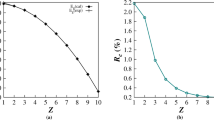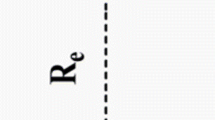Abstract
Heavy-hole trions of transition metal dichalcogenides (TMDCs) have 2D counterpart \(H^{-}\). Thus, 2D He-isoelectronic ions can be the ideal model for it even within Born–Oppenheimer (BO) approximation depending on versatile mass ratios. Schr\(\ddot{o}\)dinger equation of such systems is a long-standing problem because of secular divergence of Coulomb interactions. Analytical description of Coulomb (exchange) potential by algebraic-calculus Green’s function multipole expansion for ground-state energy (GSE) of 2D He-isoelectronic ions and binding energies of TMDCs has become one of indispensable methods. Employing associated Laguerre polynomial and Whittaker-M or Bessel functions in planar hydrogenic orbitals furnishes exact, terminable, simple and finitely summed integrals in terms of Lauricella functions for multipoles and also remedies the difficulties due to different scaling factors of higher-order perturbation calculations. Monopole and dipole factors are exploited upto third-order perturbation corrections of GSE with singly and doubly excited hydrogenic orbitals. The orbitals with circular and dumbbell symmetries exhibit GSEs differing 1.82% from reported results for 2D He atom. Binding energies of heavy-hole trions of TMDCs are observed to be in good agreement with the experimentally reported results.
Graphic abstract





Similar content being viewed by others
Data Availability Statement
This manuscript has no associated data or the data will not be deposited. (Authors’ comment: The authors confirm that the data supporting the findings of this study are available within the article).
References
A. Görlitz, J.M. Vogels, A.E. Leanhardt, C. Raman, T.L. Gustavson, J.R. Abo-Shaeer, A.P. Chikkatur, S. Gupta, S. Inouye, T. Rosenband, W. Ketterle, Phys. Rev. Lett. 87, 130402 (2001)
A. Castro Neto, F. Guinea, N. Peres, K. Novoselov, A. Geim, Rev. Mod. Phys. 81 (2007). https://doi.org/10.1103/RevModPhys.81.109
A. Ramasubramaniam, Phys. Rev. B 86, 115409 (2012)
M. Durnev, M. Glazov, Phys. Uspekhi 61 (2017). https://doi.org/10.3367/UFNe.2017.07.038172
A. Chernikov, T.C. Berkelbach, H.M. Hill, A. Rigosi, Y. Li, O.B. Aslan, D.R. Reichman, M.S. Hybertsen, T.F. Heinz, Phys. Rev. Lett. 113, 076802 (2014)
M. Ugeda, A. Bradley, S. Shi, F. da Jornada, Y. Zhang, D. Qiu, W. Ruan, S. Mo, Z. Hussain, Z. Shen, F. Wang, S. Louie, M. Crommie, Nat. Mater. 13, 1091 (2014)
K. Mak, K. He, C. Lee, G. Lee, J. Hone, T. Heinz, J. Shan, Nat. Mater. 12, 207 (2013)
Y. You, X. Zhang, Y. Berkelbach, et al. , Nat. Phys. 11, 477–481 (2015)
K.F. Mak, C. Lee, J. Hone, J. Shan, T.F. Heinz, Phys. Rev. Lett. 105, 136805 (2010)
T.C. Berkelbach, M.S. Hybertsen, D.R. Reichman, Phys. Rev. B 88, 045318 (2013)
I. Kylänpää, H.-P. Komsa, Phys. Rev. B 92, 205418 (2015)
M.Z. Mayers, T.C. Berkelbach, M.S. Hybertsen, D.R. Reichman, Phys. Rev. B 92, 161404 (2015)
A. Arora, T. Deilmann, T. Reichenauer, J. Kern, S. Michaelis de Vasconcellos, M. Rohlfing, R. Bratschitsch, Phys. Rev. Lett. 123, 167401 (2019)
K. Varga, D. Kidd, D. Zhang, Nano Lett. (2015). https://doi.org/10.1021/acs.nanolett.5b03009
D.W. Kidd, D.K. Zhang, K. Varga, Phys. Rev. B 93, 125423 (2016)
J. Yan, K. Varga, Phys. Rev. B (2020). https://doi.org/10.1103/PhysRevB.101.235435
S.-Y. Shiau, M. Combescot, Y.-C. Chang, Phys. Rev. B 86, 115210 (2012)
C. Kittel, A.H. Mitchell, Phys. Rev. 96, 1488 (1954)
I.R. Lapidus, Am. J. Phys. 50, 45 (1982)
B. Zaslow, M.E. Zandler, Am. J. Phys. 35, 1118 (1967)
W. Kohn, J.M. Luttinger, Phys. Rev. 98, 915 (1955)
S.K. Adhikari, Am. J. Phys. 54, 362 (1986)
X. Yang, S. Guo, F. Chan, K.W. Wong, W.-Y. Ching, Phys. Rev. A 43, 1186 (1991)
D. Parfitt, M. Portnoi, AIP J. Math. Phys. (2002). https://doi.org/10.1063/1.1503868
V.V. Skobelev, S.V. Kopylov, Russ. Phys. J. 61, 1597 (2019)
S.H. Patil, Eur. J. Phys. 29, 517 (2008)
J.M. Kosterlitz, D.J. Thouless, J. Phys. C Solid State Phys. 6, 1181 (1973)
J. Dash, Phys. Rep. 38, 177 (1978)
H. Kaur, S. Singh, P. Aggarwal, S. Sharma, S. Yadav, R.K. Hazra, ACS Omega 2, 7410 (2017). https://doi.org/10.1021/acsomega.7b00886
H. Kaur, S. Sharma, P. Aggarwal, R.K. Hazra, Phys. E Low-Dimens. Syst. Nanostruct. 108, 347 (2019)
S. Singh, H. Kaur, S. Sharma, P. Aggarwal, R.K. Hazra, Phys. E Low-Dimens. Syst. Nanostruct. 88, 289 (2017)
S. Sharma, P. Aggarwal, R.K. Hazra, Mol. Phys. (2020). https://doi.org/10.1080/00268976.2020.1770881
S. Sharma, B. Kapil, P. Aggarwal, R.K. Hazra, Phys. Open 11, 100107 (2022)
J. Dutta, S. Mukherjee, K. Naskar, S. Ghosh, B. Mukherjee, S. Ravi, S. Adhikari, Phys. Chem. Chem. Phys. 22, 27496 (2020)
M. Baer, Phys. Rep. 358, 75 (2002)
B. Mukherjee, K. Naskar, S. Mukherjee, S. Ghosh, T. Sahoo, S. Adhikari, Int. Rev. Phys. Chem. 38, 287 (2019). https://doi.org/10.1080/0144235X.2019.1672987
R.P. Feynman, Phys. Rev. 56, 340 (1939)
W. Lichten, Phys. Rev. 164, 131 (1967)
F.T. Smith, Phys. Rev. 179, 111 (1969)
D.J. Griffiths, Introduction to Electrodynamics; 4th ed. (Pearson, Boston, 2013); re-published by Cambridge University Press in 2017
J.D. Jackson, Classical Electrodynamics, 2nd edn. (Wiley, New York, 1975)
F. Caruso, V. Oguri, F. Silveira, A. Troper, EPL 128, 22001 (2019)
F. Caruso, A. Troper, V. Oguri, F. Silveira, Eur. Phys. J. D 74, 240 (2020)
F. Caruso, V. Oguri, F. Silveira, Phys. E Low-Dimens. Syst. Nanostruct. 105, 182–185 (2019)
C. Cohen-Tannoudji, B. Diu, F. Laloë, Quantum Mechanics (Wiley, 1977)
G.B. Arfken, H.J. Weber, Mathematical Methods for Physicists, 4th edn. (Academic Press, San Diego, 1995)
H. Eyring, J. Walter, G. Kimball, Quantum Chemistry (Wiley, 1947)
C. Zhang, H. Wang, W. Chan, C. Manolatou, F. Rana, Phys. Rev. B 89, 205436 (2014)
Y. Zhang, H. Li, H. Wang, R. Liu, S.-L. Zhang, Z.-J. Qiu, ACS Nano 9, 8514 (2015)
A. Singh, G. Moody, S. Wu, Y. Wu, N.J. Ghimire, J. Yan, D.G. Mandrus, X. Xu, X. Li, Phys. Rev. Lett. 112, 216804 (2014)
T.C. Berkelbach, M.S. Hybertsen, D.R. Reichman, Phys. Rev. B 88, 045318 (2013)
A. Chernikov, T.C. Berkelbach, H.M. Hill, A. Rigosi, Y. Li, O.B. Aslan, D.R. Reichman, M.S. Hybertsen, T.F. Heinz, Phys. Rev. Lett. 113, 076802 (2014)
A. Arora, T. Deilmann, T. Reichenauer, J. Kern, S. Michaelis de Vasconcellos, M. Rohlfing, R. Bratschitsch, Phys. Rev. Lett. 123, 167401 (2019)
A. Srivastava, M. Sidler, A.V. Allain, D.S. Lembke, A. Kis, A. Imamoğlu, Nat. Phys. 11, 66 (2015)
S. Chen, T. Goldstein, T. Taniguchi, W.K., J. Yan, Nat. Commun. 9, 3717 (2018)
H. Kaur, S. Sharma, P. Aggarwal, R.K. Hazra, Phys. E Low-Dimens. Syst. Nanostruct. 108, 347 (2019)
J.S. Ross, S. Wu, H. Yu, N.J. Ghimire, A.M. Jones, G. Aivazian, J. Yan, D.G. Mandrus, D. **ao, W. Yao, X. Xu, Nat. Commun. 4, 66 (2013)
R. Shankar, Principles Of Quantum Mechanics (Springer, 1977)
W. Feller, An Introduction to Probability Theory and Its Applications (Wiley, 1968)
A. Erdélyi, Monatshefte für Mathematik und Physik 46, 1 (1937)
V.F. Tarasov, Int. J. Mod. Phys. B 24, 4181 (2010)
A. Cerquetti, Ar**v e-prints (2010). ar**v:1012.1243 [math.PR]
H. Buchholz, The Confluent Hypergeometric Function with Special Emphasis on Its Applications (Springer, 1969), p. 15
Acknowledgements
We express our sincere thanks to Professor Shankar Prasad Bhattacharyya for valuable discussion. Our sincere thanks go to CSIR (SRF scheme) and FRP Grant under Institution of Eminence, University of Delhi (Ref. No./IoE/2021/12/FRP), for their financial support.
Author information
Authors and Affiliations
Corresponding author
Appendices
Appendix 1: 2D Coulomb interaction and Green\('\)s function expansion (algebraic-calculus approach)
The free electrostatic Green\('\)s function expansion of 2D Coulomb interaction reads as [41]:
where \(x=\big (\frac{r_{<}}{r_{>}}\big )\), \(B_m(\phi )=\frac{T_m(cos(\phi ))}{m}, \phi =\phi _i-\phi _j\) and \(T_m(cos(\phi ))\) is the Chebyshev Polynomial.
where
Therefore, it is clearly seen from Eq. (47) that it can be expanded in polynomial expansion of x as:
Differentiating Eq. (48) w.r.t. x n-times,
Now \(f_k\) can be written as:
where \(M=\sum _{m=1}^{\infty }mr_m\). The nth derivative of \(f_k\) w.r.t. x can be written as:
Substituting Eq. (51) in Eq. (49):
Letting \(x=0\), terms with \(q>n\) and \(M>n\) on L.H.S. and R.H.S., respectively, vanish.
From Eq. (53), it can easily be evaluated that for monopole (\(n=0\))\(\Rightarrow\) \(A_0=1\), dipole (\(n=1\))\(\Rightarrow\) \(A_1=cos(\phi )\), quadrupole (\(n=2\))\(\Rightarrow\) \(A_2=\frac{cos^2(\phi )+cos(2\phi )}{2}=\frac{3cos^2(\phi )-1}{2}\), octupole (\(n=3\))\(\Rightarrow\) \(A_3=\frac{cos^3(\phi )+3cos(\phi )cos(2\phi )+2cos(3\phi )}{6}=\frac{5cos^3(\phi ) -3cos(\phi )}{2}\) and so on. It is clear from Eq. (53) that \(A_n(\phi ) = P_n(\cos (\phi ))\), Legendre Polynomial. This is unprecedentedly improvised explicit relation between Chebyshev and Legendre polynomials, best to our knowledge. We believe that applying principle of mathematical induction, 2D Coulomb potential can be conjectured as:
Appendix 2: Dipole factor (\(l=1\))
On substituting the values of \(I_1\) and \(I_2\) in Eq. (31) and taking \(\xi (\alpha _1r_i)\) and \(\xi (\alpha '_1r_i)\) in Whittaker-M function form, the integrals \(I_s\) and \(I_g\) become:
Employing the standard integral (Eq. (64)) to solve \(I_{s_a}, I_{s_b}\) and \(I_{g_a}\) results in the following finite double summed forms.
For \({{\varvec{I}}}_{{{\varvec{s}}}_{{\varvec{a}}}}, \varrho = -1, c=0, a_1 = \alpha _1, a_2 = \alpha '_1, A = \frac{1}{2}(\alpha _1+\alpha _2), c+A = \frac{\alpha _1+\alpha '_1}{2}, \gamma _1 = |m_1|+\frac{1}{2}, \gamma _2 = |m'_1|+\frac{1}{2}, M = \gamma _1+\gamma _2 = |m_1|+|m'_1|+1, \kappa _1=n_1-\frac{1}{2}, \kappa '_1=n'_1-\frac{1}{2}\):
For \({{\varvec{I}}}_{{{\varvec{s}}}_{{\varvec{b}}}}, \varrho = s-1, c = \frac{(w+1)\alpha _2}{2}, a_1 = \alpha _1, a_2 = \alpha _2, A = \frac{1}{2}(\alpha _1+\alpha _2), c+A = \frac{(w+1)\alpha _2+\alpha _1+\alpha '_1}{2}, \gamma _1 = |m_1|+\frac{1}{2}, \gamma _2 = |m'_1|+\frac{1}{2}, M = \gamma _1+\gamma _2 = |m_1|+|m'_1|+1, \kappa _1=n_1-\frac{1}{2}, \kappa '_1=n'_1-\frac{1}{2}\):
Similarly for \({{\varvec{I}}}_{{{\varvec{g}}}_{{\varvec{a}}}}, \varrho = s+2, c = \frac{(w+1)\alpha _2}{2}, a_1 = \alpha _1, a_2 = \alpha _2, A = \frac{1}{2}(\alpha _1+\alpha _2), c+A = \frac{(w+1)\alpha _2+\alpha _1+\alpha '_1}{2}, \gamma _1 = |m_1|+\frac{1}{2}, \gamma _2 = |m'_1|+\frac{1}{2}, M = \gamma _1+\gamma _2 = |m_1|+|m'_1|+1, \kappa _1=n_1-\frac{1}{2}, \kappa '_1=n'_1-\frac{1}{2}\):
Substituting Eqs. (57–59) in Eq. (31), we get:
Adding Eqs. (60) and (61) gives the exact value of the integral (Eq. (31)).
Appendix 3: Standard equations and integrals
Associated Laguerre Polynomial [46]
Lower and Upper Incomplete Gamma function[46]
Standard Integral-I (Erdélyi’s Integral) [60]
where \(Re(\varrho +M)>\)0, \(Re\left( c\pm \frac{1}{2}a_1\pm \frac{1}{2}a_2\right) >0\) and \(M = \gamma _1+\gamma _2\)
\(F_2\) to \(F_1\) relation [61]
Chu-Vandermonde identity [62]
Standard Integral-II (Erd\(\acute{e}\)lyi’s Integral) [63]
where \(Re(\sigma )>0, Re(b) >0\)
Rights and permissions
About this article
Cite this article
Kapil, B., Sharma, S., Aggarwal, P. et al. Binding energies and current density of heavy-hole trions of monolayer transition metal dichalcogenides: analytical perturbation treatment of Coulomb interaction with 2D H-like basis set. Eur. Phys. J. Plus 137, 809 (2022). https://doi.org/10.1140/epjp/s13360-022-02970-7
Received:
Accepted:
Published:
DOI: https://doi.org/10.1140/epjp/s13360-022-02970-7




